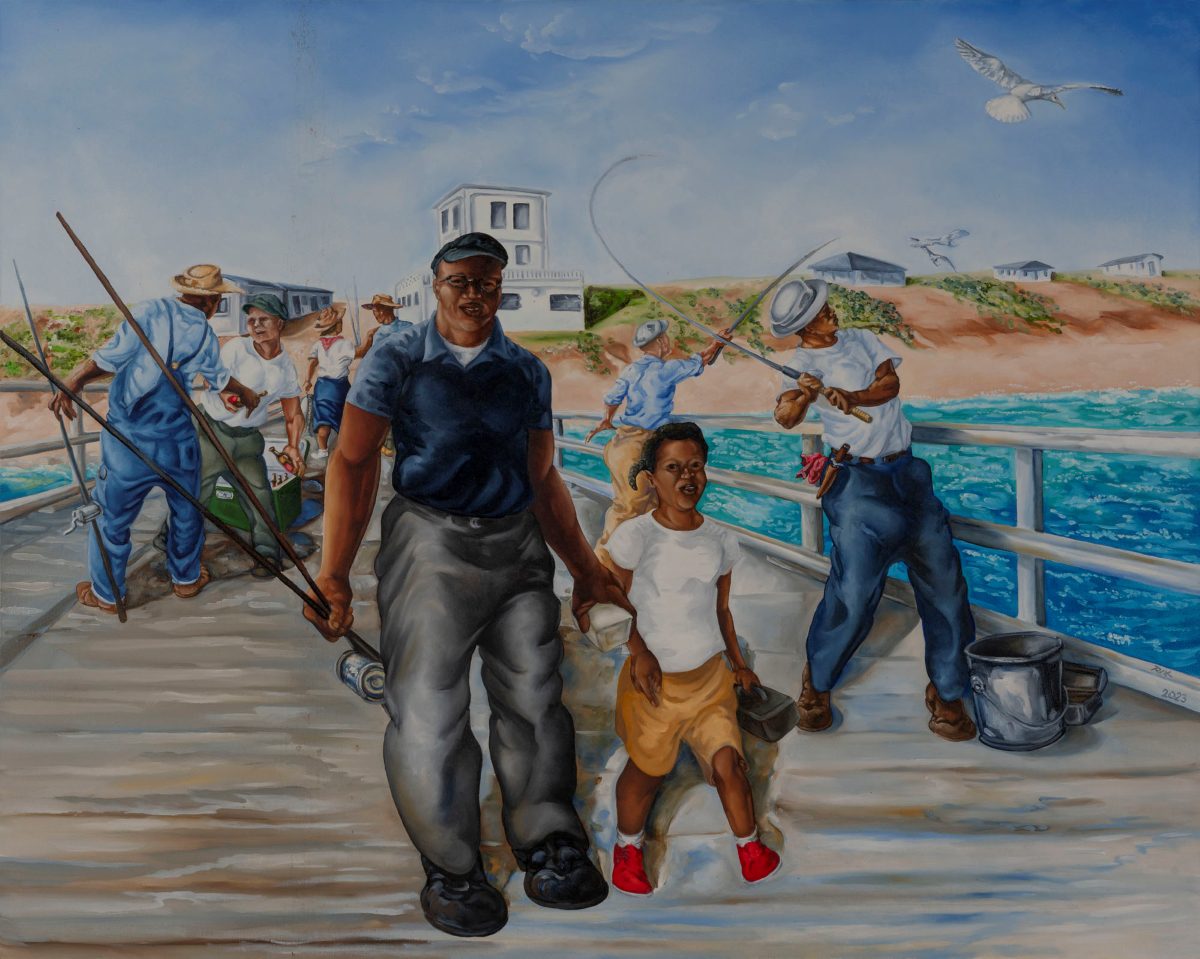A dory awaits fall and the start of the mullet season.
 From left, Henry Frost, Tom Guthrie and Phil Guthrie are maintaining a century-old tradition of netting jumping mullet from the beaches of Bogue Banks, |
 The red, Farmall tractors are a sure sign of fall along Bogue Banks. |
SALTER PATH – Outsiders may not know it, but those two large, red tractors pointed in opposite directions in an abandoned parking lot in this tiny barrier island community in Carteret County are certain signs of fall..
Supporter Spotlight
So is the quiet. Labor Day has passed, and with most of the tourists departed, the traffic hum from the highway that slices through the town is now gone, allowing the cry of a royal tern to be noticed.
|
The amount of sunlight each day is waning, and it will soon be at a day of balance. This transition to longer nights and from warmth to cold signals the equinox of autumn. The Latin meaning of the word “equinox” is equal night.
Astronomically speaking, the September equinox occurs the moment the sun crosses the celestial equator – the imaginary line in the sky above the Earth’s equator – from north to south. This happens either on Sept. 22, 23 or 24 every year. Along the N.C. coast, it happened about 10:30 last night.
That’s when fall officially began. It is hard to escape the signs, as a peregrine falcon swoops after migrating shorebirds along the beach, the muscadine grapes hang heavy on vines and the yellow cloudless sulphur butterflies dance through the air. To the natives of Salter Path and Bogue Banks, those red tractors sprouting up along the beach are as much a natural sign of fall as the goldenrod that is blooming among the sandy dunes.
When I first noticed the tractors, three men were stringing, or tying on, a new net onto a rope that stretched from the axel of one tractor to the other tractor, about 30 yards away. I have lived enough of my life in coastal North Carolina to know that these men were preparing for the ritual harvest of striped mullet.
Supporter Spotlight
Henry Frost, Phil Guthrie and Tom Guthrie, collectively have 170 years of mullet fishing experience. They were preparing for another season.
“Why?” I asked.
“Fun” was the answer.
While tying on the net, they also threaded in brown floats every three feet on the top of the net and silvery lead weights about every foot on the bottom. As I talked to the men, dark storm clouds announced the arrival of a cool front pushing across the sound. The snapping lightning and rumble of thunder in the distance had me nervously glancing towards the sky, while the men, undaunted, kept a steady hand threading the twine through the net anchoring it onto the line.
The striped mullet, also known as the flathead mullet and jumping mullet, is not that interested in biting a baited hook and is content to suck up small algae, zooplankton and decaying organic matter from sandy and muddy bottoms. Every fall, thousands of this oily fish migrate out of the estuaries then swim close to the shore before heading offshore to spawn.
These fish practically founded the town of Salter Path. In the late 1800’s, the collapse of the whaling trade and pounding hurricanes encouraged some residents of the Shackleford Banks community of Diamond City to relocate westward to the island of Bogue Banks. These hardy souls took advantage of a fish that practically swam onto the shore. Once their nets were pulled onto the beach, the fish were cleaned and salted down in wooden barrels.

Using the tractors, fishermen haul the net full of mullet onto the beach.
As the heavy barrels were carried from the beach to the sound, a well-worn path was etched into the ground through the thick maritime shrub thickets. At the end of this path, the barrels were loaded onto boats, destined for various locations. This path went right past a house owned by one Riley Salter, and soon, the town once called Gillikin, became known as Salter Path.
These settlers also relied on the salted mullet to barter for other commodities with mainland farmers offering sweet potatoes and corn. Along with being salted, the mullet was also dried and smoked to provide a few options since this fish would also sustain them through the lean winter months.
Throughout the 1900’s the annual mullet harvest supported about eight crews along the length of Bogue Banks. Each crew with its own unique name, such as Clam Rock, Red Bird, Money Island, Tea House, Hopey Ann Hill and Bell Cove, that typically reflected a landmark on the island.
It was a good business, according to Frost, until Hurricane Hazel raked across the banks in 1954. The storm, he said, reorganized the topography and profile of the near shore ocean bottom and the character of the mullet runs has never been the same.
A school of mullet in the surf. |
 The mullet are loaded into the back of pickup trucks for the trip to the market in Beaufort. |
Since then, the number of crews slowly dwindled down leaving only two active crews today. These two crews now actually join together and operate as one to increase the chances of a successful season.
Last fall, during October and November, I kept a close watch on the weather forecast looking for the conditions that would trigger what is known as a “mullet blow.” A drop in water temperature and humidity are thought to be factors that prompt these fish to move out of the estuaries, through the inlets and along the barrier beaches.
Near the western point of Bogue Banks, two of the tractors and one dory boat were strategically stationed at the base of the primary dune line, ready for action. Upon close inspection, the cosmetic appearance of the rusty tractors indicates a well-worn 70-year life of splashing through the surf and pulling nets. These Farmall model M tractors were favored for their power and high clearance that allowed them to operate in the loose sand and incoming waves of the surf zone.
Connected to one of the tractors was a rugged homemade trailer that cradles an all-white, flat bottomed 20-foot dory. At first glance it appears that the boat has no motor, however, an inspection reveals a motor nestled into an open well close to the bow of the boat. The shaft of the motor actually protrudes through a hole in the bottom of the boat. This allows the 400 yards of net to be easily deployed over the stern of the boat without interference from the motor. Made by Frost, the boat maneuvers easily in shallow water and is durable enough to be launched directly into the surf.
In early November, a strong cold front escorting a stiff north wind sent the mullet running west close to the shore. Before sunrise, the fishing crew was already on the beach starting the tractors, inspecting the nets and fueling the boats. As the sun kissed the horizon, they began to patrol the beach and scan the water looking for what looks like the dark shadow of a cloud passing under the sun.
Around 9 a.m. a school was spotted near the Bogue Inlet pier in Emerald Isle and a parade of tractors, with a dory in tow and pickup trucks hustled down the beach. The tractor with the dory was able to get down the beach ahead of the fish with enough time to allow the fishermen to deploy the boat directly into the surf. A few of the men pushed the dory off the trailer and spun the bow into the small ocean waves. One man leaped into the dory, and the motor roared quickly to life.
Heading out perpendicular from the shore, the dory was spilling out a net from the stern with one end anchored to the tractor. The dory quickly made a big loop around the schooling fish, headed straight back to the shore and ran directly onto the beach as the other tractor driver anxiously awaited.
A few more men jerked and pulled the net out of the dory and attached it to the Farmall. Both tractors then pulled the net, bulging with mullet, onto the beach just above the lapping waves. A line of men secured the bottom of the net to make sure none of the flapping fish escaped. It was all over in about five minutes.
 The tractor pulls the dory along the beach as the sun rises and other fishermen scan the surf for jumping mullet. |
The coordination of the strike was flawless. As the men called out instructions to each other, their Down East brogue became more pronounced and verged on being a foreign language. The number of hoot and hollers from the crew relieved that the operation went off without a hitch.
Recently, Neil Smith and Joey Frost, each with 45 and 40 years of experience working on a mullet crew, told me stories about times when things didn’t go so well, including swamped boats and waves breaking over tractors. But they also spoke of the rush of adrenaline and joy that pours through the body after the teamwork of 18 men results in a net full of fish.
The anxiousness and nervousness of the strike was over and the men now playfully teased each other as they began the real work of the day, loading the fish into a cluster of pickup trucks. Together, all the men in waders and rain slickers dropped to their knees and began pulling the slippery mullets bare handed from the net and tossing them into baskets. Once full, the baskets were dumped into the bed of a full size pickup truck.
Before long, a residue of slime, scales and sand coated their clothing. This haul, at 12,000 pounds seemed generous; however, the older men who had seen better days knew it was a modest catch.
As I watched them stowing their nets, a song about lobster fishing in Maine, by Dan Fogelberg, “The Reach,” popped into my head:
It’s father and son,
It’s the way it’s been done since the old days.
These mullet headed to a local fish house in Beaufort where some were sold locally but the majority were shipped to Florida. Some were salted, others dried or smoked.
However, the female mullet, plump with red roe is much more valuable. The roe is bound for the markets in Taiwan and other Asian countries where it is a delicacy.
Today, in the United States, the mullet is looked down upon as only suitable for fish or crab bait. Yet, there is a modest following that love their mullet grilled over charcoal, fried, broiled or stewed. The mullet is even celebrated with an annual festival during the October mullet season in Swansboro.
Those early Salter Path families started a tradition of mullet fishing on Bogue Banks that has been going on for over 100 years. Great-grandfathers, grandfathers, fathers and sons have stood together pulling the nets, feeling the chilling north wind of a mullet blow on the back of their necks. They don’t do it for the money, because it is humble at best. The goal is to break even, hope to make a little money and pray not to lose any. It is family, community, camaraderie, tradition and heritage that keep them mending the nets, repairing the tractors and boats and waiting. Waiting for another day when the north wind blows cold, the ocean lays flat and the mullet run thick to teach another generation the pride of their ancestors.








